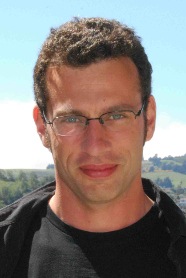Associate Professor

- Location
- Room 416
- Phone numbers
- 4121 (Office)
64 3 479 4121 (Office Direct Dial) - ashton.bradley@otago.ac.nz
- Research Group
- https://amoqt.otago.ac.nz/people/asbradley
Biography
I obtained my undergraduate degree and MSc in Physics from the University of Auckland. I then gained a PhD in theoretical physics at the Victoria University of Wellington in 2006, in the group of Professor Crispin Gardiner. I took up a post-doctoral position at the University of Queensland in the Center of Excellence for Quantum-Atom Optics. In 2008 I moved to the University of Otago to take up a FRST Research Fellowship. In 2011-2016 I held a Rutherford Discovery Fellowship, and in 2016 I started a Senior Lectureship at the University of Otago.
Expertise and Research Interests
I am primarily interested in ultra-cold matter waves. Since the discovery of dilute gas Bose-Einstein condensation in 1995, the physics of nano-Kelvin matter waves has been a fascinating field of scientific exploration. The field is characterized by mesoscopic quantum systems with an unrivaled level of characterization and control, thus enabling rigorous tests of theoretical concepts and clean analog realizations of phenomena that are difficult to study in other settings. Fundamental advances have been achieved in many areas, from analog models of relativistic phenomena such as the Hawking Effect, to our basic understanding of superfluidity and tests of the Kibble-Zurek theory of symmetry breaking in dynamical phase transitions.
My current interests focus on vortex dynamics in two dimensional superfluid flows. Such systems have the advantage that the dynamics of quantum vortices is reduced to motion on a plane. The system thus affords a very minimal realization of turbulent superfluid dynamics, offering the possibility of new insights into the basic properties of turbulent flows in general.
Open Quantum Systems
The celebrated Stochastic Gross-Pitaevskii equation has become a cornerstone of finite-temperature many body theory for the ultra-cold Bose gas. Yet all applications so far have focused on the so-called growth interaction in the reservoir theory, involving incoherent particle exchange between thermal cloud and superfluid. This treatment is appropriate when the system dynamics are not far from equilibrium. A complete reservoir theory includes additional interaction processes that transfer energy while conserving the number of superfluid particles. Such interactions are important in experiments involving far-from-equilibrium dynamics, a research focus of many groups. The dissipative dynamics have immediate implications for the decay of coherent excitations such as vortices and solitons, and provide a theoretical framework for studying quantum turbulence in finite-temperature superfluids.
Quantum Turbulence
An energy cascade in turbulent fluid flows involves the conserved transfer of kinetic energy across length scales. In classical 3D turbulence, large-scale forcing leads to a cascade of energy and vorticity toward smaller scales. In stark contrast, small-scale forcing in 2D fluids can cause an inverse energy cascade (IEC), associated with energy flux toward larger scales, and the emergence of macroscopic rotating structures from the turbulent flow. The IEC has been widely studied in classical fluids and observed over a large range of scales, from soap films to planetary atmospheres. Yet an experimental realization in a superfluid has remained elusive. Our work focuses on creating such flows and studying their emergent statistical properties.
Publications
Krause, N. A., & Bradley, A. S. (2024). Thermal decay of planar Jones-Roberts solitons. Physical Review A, 110, 053302. doi: 10.1103/PhysRevA.110.053302 Journal - Research Article
Reeves, M. T., Goddard-Lee, K., Gauthier, G., Stockdale, O. R., Salman, H., Edmonds, T., Yu, X., Bradley, A. S., … Neely, T. W. (2022). Turbulent relaxation to equilibrium in a two-dimensional quantum vortex gas. Physical Review X, 12, 011031. doi: 10.1103/PhysRevX.12.011031 Journal - Research Article
Gauthier, G., Reeves, M. T., Yu, X., Bradley, A. S., Baker, M. A., Bell, T. A., … Neely, T. W. (2019). Giant vortex clusters in a two-dimensional quantum fluid. Science, 364(6447), 1264-1267. doi: 10.1126/science.aat5718 Journal - Research Article
Sompet, P., Szigeti, S. S., Schwartz, E., Bradley, A. S., & Andersen, M. F. (2019). Thermally robust spin correlations between two 85Rb atoms in an optical microtrap. Nature Communications, 10, 1889. doi: 10.1038/s41467-019-09420-6 Journal - Research Article
Yu, X., & Bradley, A. S. (2017). Emergent non-Eulerian hydrodynamics of quantum vortices in two dimensions. Physical Review Letters, 119(18), 185301. doi: 10.1103/PhysRevLett.119.185301 Journal - Research Article